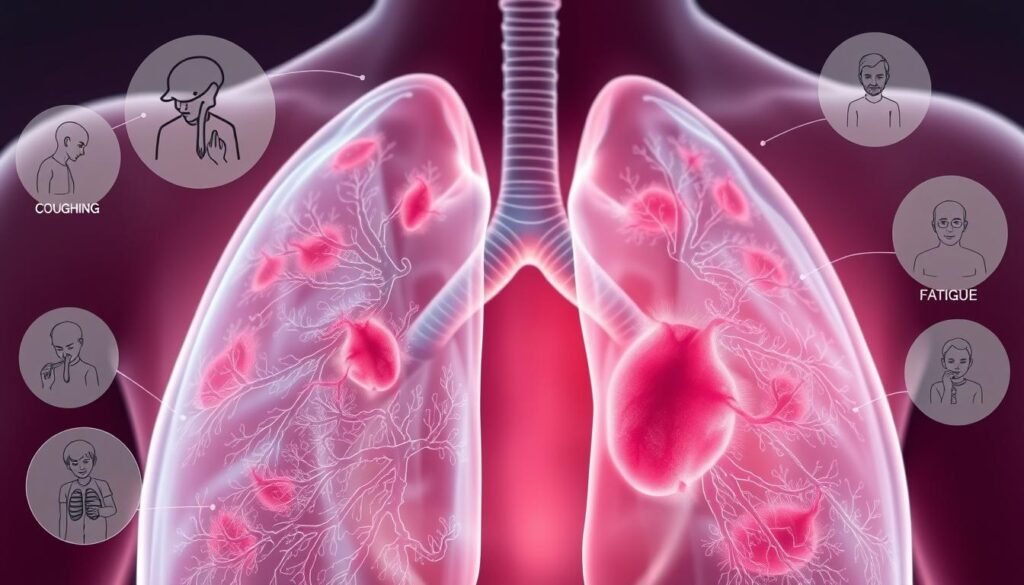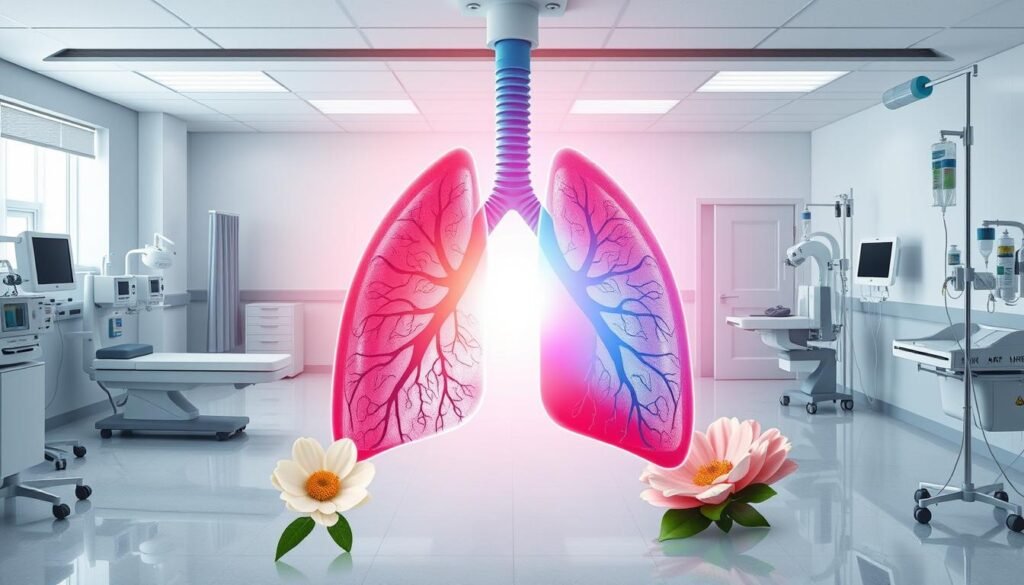Did you know nearly 4% of chest radiotherapy patients may get chronic radiation pneumonitis? This results in a constant cough and breathlessness. This fact highlights why knowing about side effects to lung cancer treatments is key. Going through lung cancer treatment, patients often tackle physical and mental hurdles. These arise from both the disease and treatments.
It’s vital to know the side effects. These can range from tiredness and nausea to serious long-term issues like thinking problems and lung tissue changes. Patients and caregivers must understand these effects. By doing so, patients can make smart choices about their lung cancer treatment. Working with healthcare providers is crucial to manage these issues well. Open talks with a supportive medical team can improve the treatment journey and overall health.
To dive deeper into long-term side effects of radiation and their impact, think about checking this informative resource. Learning about these risks is key to using proactive strategies for better health during treatment.
Key Takeaways
- Long-term and short-term side effects affect patient’s quality of life.
- Monitoring blood cell levels is essential throughout treatment.
- Cognitive side effects may occur and vary from person to person.
- Managing diet and exercising can mitigate many side effects.
- Open communication with healthcare providers is crucial.
- Specific interventions can manage side effects effectively.
- Understanding side effects aids in better treatment decisions.
Lung Cancer Overview
Lung cancer is a big health issue, affecting over 43,000 people each year in the UK. The disease mostly comes in two forms: non-small cell lung cancer (NSCLC) and small cell lung cancer (SCLC). NSCLC makes up about 80 to 85 out of every 100 cases. This category includes different types, like adenocarcinoma, squamous cell carcinoma, and large cell carcinoma. Adenocarcinoma is the most common, while squamous cell carcinoma is often linked to smoking.
Smoking is the top cause of lung cancer. It’s behind more than 70 out of every 100 cases. Other things, like secondhand smoke and pollution, also play a role in increasing lung cancer cases. It’s key to know what causes lung cancer. This helps in its prevention and early finding, which can greatly improve chances of survival.
Lung cancer stages tell how far the disease has spread. This is very important because it decides the treatment options and possible side effects. Catching the disease early usually means a better chance at living longer. About 2 in 5 people diagnosed with lung cancer survive for at least a year. Sadly, only about 1 in 10 lives for 10 years or more.
Lung cancer can also start in other parts of the body and move to the lungs. When this happens, it’s called metastatic cancer. These types of cancer are named after where they started, not as lung cancer. To fully understand lung cancer, knowing these differences is crucial. For a detailed lung cancer overview, it’s important to recognize these points.
Lung Cancer Symptoms
Lung cancer is the top cause of cancer deaths worldwide. Knowing the main symptoms can lead to early detection and better treatment results. Some common symptoms are:
- Persistent or worsening cough
- Coughing up blood
- Chest pain that worsens with deep breathing, laughing, or coughing
- Shortness of breath
- Hoarseness
- Unexplained weight loss
- Fatigue
- Recurrent infections like bronchitis or pneumonia
- New onset wheezing

These symptoms could be from other conditions, but early notice is key. If you have these symptoms, especially with risks like smoking, see a doctor. Catching lung cancer early greatly improves treatment success.
If the cancer spreads, you might notice other symptoms such as:
- Bone pain
- Nervous system changes
- Swelling of lymph nodes
- Jaundice
Non-small cell lung cancer can cause Pancoast tumors, which may lead to severe shoulder pain or nerve issues. Recognizing these symptoms early can save lives. Knowing them helps people get timely help, improving their chances of beating lung cancer.
Understanding Side Effects to Lung Cancer
Lung cancer treatment can lead to side effects that affect life quality. Recognizing these effects is vital for managing them well.
Common Side Effects from Treatments
Different lung cancer treatment methods cause various side effects. Surgery may cause pain and breathing issues. Chemotherapy often leads to nausea, tiredness, and hair loss. Radiation therapy might cause problems such as:
- Difficulty swallowing
- Feeling or being sick
- Shortness of breath
- Cough
- Chest wall pain
Eating soft foods and staying hydrated helps relieve symptoms. Consulting healthcare experts for diet or medicine adjustments is wise. On resources like radiotherapy side effects, you can learn more on managing these issues.
Long-term Effects of Treatment
Both immediate and long-term effects of treatment need attention. Some may experience nerve pain or heart issues after radiation. Breathlessness might continue, affecting lung function over time. It’s key to stay in touch with doctors to tackle these problems quickly. Regular check-ups help catch new issues early. Knowing about lung cancer’s side effects helps patients take charge of their health.
Lung Cancer Treatment Options
Lung cancer treatments are designed to fit the patient’s needs and cancer type. Talking with doctors is key to choose the best plan. Treatments include surgery, chemotherapy, radiation, and immunotherapy. Each has benefits and side effects.
Surgery
Surgery for lung cancer tries to remove the cancer. It can be a wedge resection, segmental resection, lobectomy, or pneumonectomy. The surgery choice depends on the cancer’s size and place. Early-stage patients often see better results from surgery.
Chemotherapy
Chemotherapy kills remaining cancer cells after surgery or as the main treatment when cancer is advanced. It’s usually paired with radiation to work better. Side effects like nausea and tiredness are common.
Talking about these side effects with doctors is crucial. Knowing all chemotherapy options helps patients during their treatment.
Radiation Therapy
Radiation therapy uses energy rays to attack cancer cells. It’s done before or after surgery to control cancer spread. Techniques like stereotactic body radiotherapy focus on small tumors.
For more on radiation treatment prep, visit here.
Immunotherapy
Immunotherapy boosts the immune system to fight lung cancer. It’s promising, especially for non-small cell lung cancer. Learning about this new treatment gives hope and confidence to patients.

| Treatment Type | Purpose | Common Side Effects |
|---|---|---|
| Lung Cancer Surgery | Resection of cancerous tissue | Pain, infection risk, lung function changes |
| Lung Cancer Chemotherapy | Eliminate residual cancer cells | Nausea, fatigue, hair loss |
| Radiation Therapy | Targeting specific tumors | Skin irritation, fatigue, coughing |
| Immunotherapy | Boost the immune system’s ability to fight cancer | Flu-like symptoms, skin reactions, fatigue |
Managing Side Effects
It’s very important to handle side effects from lung cancer treatments well. This can make life better. Those undergoing treatment often feel tired, sick, and in pain. Working with doctors and nurses is crucial. They help tailor a plan just for you, including lung cancer support.

Being tired is common. Resting and eating right can help. Also, light activities like walking or yoga can boost energy. For nausea, taking medicine prescribed by a doctor and eating small meals help. The same goes for issues like hair loss and constipation. Both need good diet and medicine focus.
For those on targeted therapy, skin problems can happen. Use moisturizers and stay out of the sun. Talking openly about any treatment troubles can also make a big difference. Using tools like medication trackers helps keep track of health.
Having trouble breathing is another issue. Medications or inhalers are needed, especially for daily tasks. Learning how to breathe better and making small changes in how you sit or your home setting can help too.
In conclusion, a plan made just for you on how to deal with side effects is key. Getting the right nutrition, controlling pain, and looking after your mental health is part of good care. To learn more, see managing lung cancer treatment side effects.
| Side Effect | Management Strategies |
|---|---|
| Fatigue | Rest, balanced diet, light exercise |
| Nausea | Anti-nausea meds, small frequent meals |
| Skin Issues | Moisturizers, sun protection, loose clothing |
| Shortness of Breath | Inhalers, breathing exercises, proper posture |
| Pain | Medications, monitoring symptoms, relaxation techniques |
Lung Cancer Stages and Their Influence on Side Effects
Lung cancer stages are key to knowing about treatment and possible side effects. They are based on the TNM system. This looks at tumor size and place (T), lymph node status (N), and if it has spread (M). Each part has a number that shows how advanced the cancer is, from stage 0 to stage IV.
Early stages like 0 and I show cancer that hasn’t spread much. These stages often mean surgery is possible. The side effects, like feeling tired and some pain, are usually less severe.
By stages II and III, the cancer needs tougher treatments. Side effects can include feeling sick, throwing up, and losing hair. Stage IV means the cancer has spread widely. Treatment side effects can get worse, especially with new drugs or immunotherapy.
Knowing the cancer stage helps patients understand what to expect. This knowledge helps both patients and doctors prepare for the journey ahead. It makes dealing with lung cancer symptoms easier, offering better support.
The following table summarizes the key attributes and potential side effects associated with different lung cancer stages:
| Lung Cancer Stage | Description | Common Side Effects |
|---|---|---|
| Stage 0 | Localized tumor; non-invasive. | Mild fatigue, local discomfort. |
| Stage I | Localized tumor; minimal spread. | Fatigue, potential surgery-related pain. |
| Stage II | More extensive local tumors; possible lymph node involvement. | Nausea, hair loss, increased fatigue. |
| Stage III | Advanced local spread; extensive lymph node involvement. | Nausea, colitis, chronic cough. |
| Stage IV | Metastatic cancer affecting other organs. | Severe fatigue, pain, multi-organ complications. |
Lung Cancer Risks and Causes
It’s vital to know lung cancer causes and lung cancer risk factors. Smoking is the biggest cause, leading to about 80% of lung cancer deaths. Using other tobacco products like cigars and pipes also poses big risks. Being around secondhand smoke is the third leading cause of lung cancer in the U.S.
Radon exposure is another top cause for non-smokers. Workers exposed to asbestos face a high risk of getting lung cancer and mesothelioma. Being around carcinogens at work also raises this risk, more so for smokers.
Other things that can increase lung cancer risk include:
- Getting radiation therapy on the chest can up your chances of lung cancer.
- Poor air quality outdoors can contribute to lung cancer, but to a lesser extent.
- If your family has a history of lung cancer, your own risk might be higher.
- Diseases that scar the lungs, like COPD and tuberculosis, can raise your risk.
- Smokers taking high doses of beta-carotene supplements might have a higher lung cancer risk.
To lower these risks, prevention is key. Not using tobacco, avoiding known carcinogens, and regular doctor visits can help. Knowing these risks lets people take steps to safeguard their health against lung cancer.
Lung Cancer Prevention Strategies
To lower lung cancer risk and boost health, a varied approach is essential. Stopping smoking is key, as it greatly affects risk levels. Studies show quitting smoking can cut lung cancer risk at any age. This is because the lungs can heal over time.
For people who smoked a lot in the past, getting checked early with low-dose CT scans is advised. This can help find lung cancer early and improve chances of survival.
Living healthy also matters a lot in preventing lung cancer. Being active and eating lots of fruits and vegetables are good steps. Just adding 100 grams more of fruits and veggies each day can reduce the risk. This is especially true for those who smoke.
Avoiding harmful air at home and outdoors is also crucial. Testing for radon in your home and staying away from air pollution can make a difference. These things are linked to lung cancer.
In conclusion, preventing lung cancer involves several key actions. Quitting smoking, eating healthily, and getting regular checks are important. These efforts not only lower your cancer risk but also help if cancer does occur. Taking action for your lung health is very important.